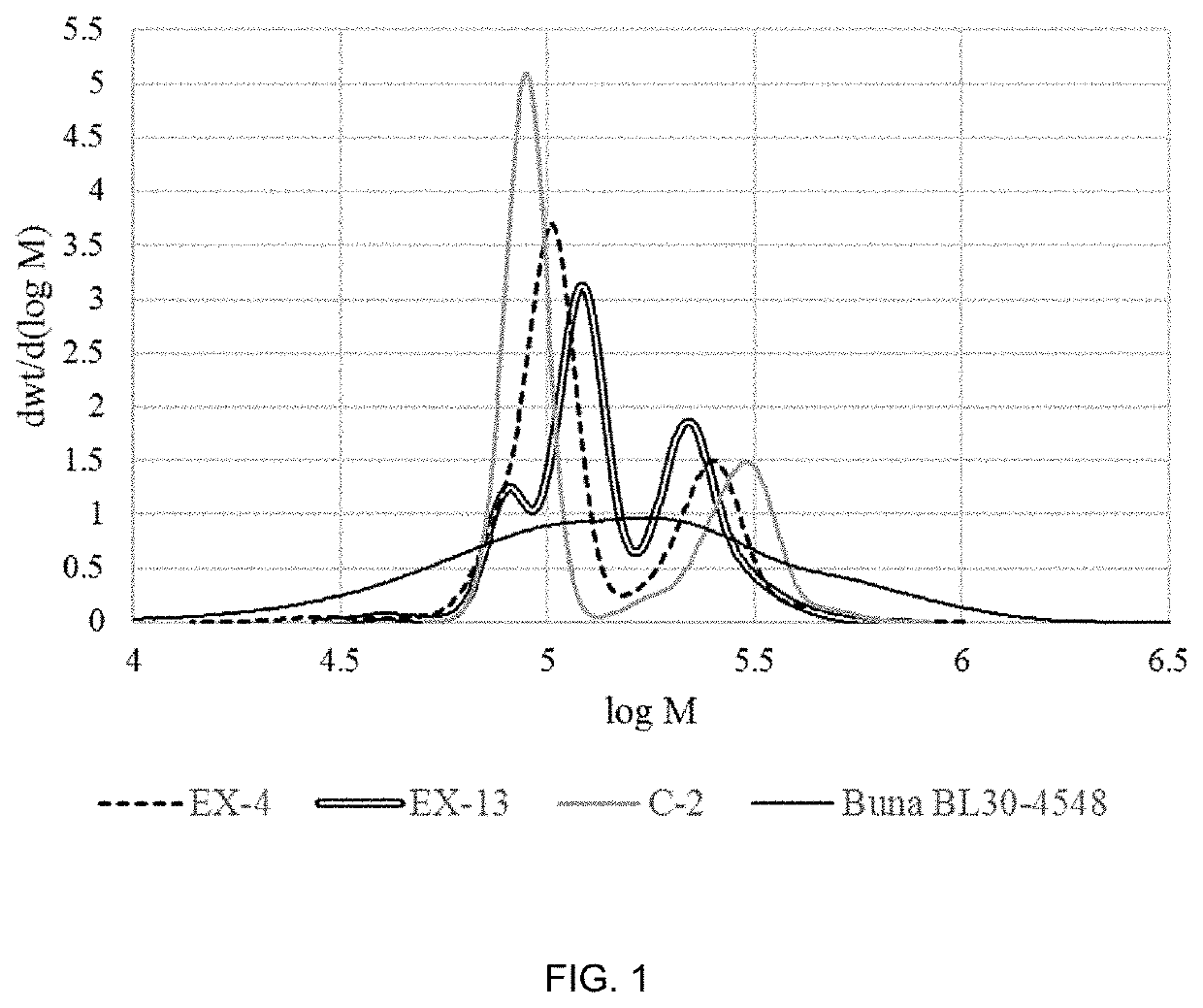Dual Composition Block Copolymers
a composition block and copolymer technology, applied in the direction of adhesives, etc., can solve the problems of premature decomposition of chemical blowing agent, high compounding temperature, shrinkage of foam rubber compounds, etc., and achieve the effect of negligible shrinkage of microcellular compounds, excellent surface appearance, and avoid premature crosslinking problems
- Summary
- Abstract
- Description
- Claims
- Application Information
AI Technical Summary
Benefits of technology
Problems solved by technology
Method used
Image
Examples
invention example 1
[0223]Synthesis of dual composition block copolymer; prototype prepared with silicon tetrachloride as coupling agent. 0.896 kg of cyclohexane, 0.042 kg of styrene and 0.105 kg of butadiene were charged to a 2-liter reactor under nitrogen atmosphere and stirring. The initial reactor charge was heated to a temperature of 74.0° C. and then 2.845 millimoles of n-butyllithium were fed to the reactor. Polymerization of the first monomer charge reached a peak temperature of 110.8° C. After a 1-minute wait, 0.188 millimoles of silicon tetrachloride coupling agent were fed to the reactor. After a 5-minute wait, 0.028 kg of styrene was fed to the reactor, during this charge, reactor temperature dropped for a moment to 91.6° C. As result of the heat of polymerization of the second styrene charge, the reaction reached a peak temperature of 94.7° C. After a 1-minute wait, 1.782 millimoles of a monofunctional alcohol were fed to the reactor to terminate polymer anions. Specific formulation and po...
invention example 2
[0252]Synthesis of dual composition block copolymer; prototype prepared with methyl silicon trichloride as coupling agent. Same procedure was employed to prepare a dual composition block copolymer as in Example 1, but 0.230 millimoles of methyl silicon trichloride were used instead of silicon tetrachloride as coupling agent. Specific formulation and polymerization process conditions for this dual composition block copolymer synthesis example are shown in Table 1. Rubber solution was then added 0.5 phr of a phenolic antioxidant and 0.6 phr of phosphite antioxidant. Block copolymer was recovered by roll milling Weight average molecular weight (Mw) of the dual composition block copolymer synthesized was 171.8 kg / mol. Molecular weight distribution exhibited a polydispersity index of 1.19. Molecular weight distribution of the block copolymer exhibited two peaks: a low molecular weight peak corresponding to an un-coupled linear tapered block copolymer of formula D-(D / A)-A2 and a high mole...
invention examples 3 to 12
[0253]Synthesis of dual composition block copolymers; prototypes sweeping viscosity, coupling and compositional difference levels. 71.50±0.14 kg of cyclohexane, either about 1.58 or about 2.56 kg of styrene and 6.64±0.02 kg of butadiene was charged to a 189-liter reactor under nitrogen atmosphere and stirring. The initial reactor temperature was set from about 56.0 to about 66.0° C. and then from about 273.0 to about 321.0 millimoles of n-butyllithium were fed to the reactor. Polymerization of the first monomer charge reached a peak temperature from about 99.7 to about 104.8° C. After a 1-minute wait, from about 13.88 to about 31.42 millimoles of silicon tetrachloride coupling agent were fed to the reactor. After a 5-minute wait, either about 2.78 or about 1.82 kg of styrene was fed to the reactor. While charging the last monomer reactor temperature dropped to about 98.1±2.4° C. As result of heat of the reaction of the polymerization of the second styrene charge, reaction temperatur...
PUM
| Property | Measurement | Unit |
|---|---|---|
| temperature | aaaaa | aaaaa |
| dynamic shear viscosity | aaaaa | aaaaa |
| dynamic shear viscosity | aaaaa | aaaaa |
Abstract
Description
Claims
Application Information
 Login to view more
Login to view more - R&D Engineer
- R&D Manager
- IP Professional
- Industry Leading Data Capabilities
- Powerful AI technology
- Patent DNA Extraction
Browse by: Latest US Patents, China's latest patents, Technical Efficacy Thesaurus, Application Domain, Technology Topic.
© 2024 PatSnap. All rights reserved.Legal|Privacy policy|Modern Slavery Act Transparency Statement|Sitemap

